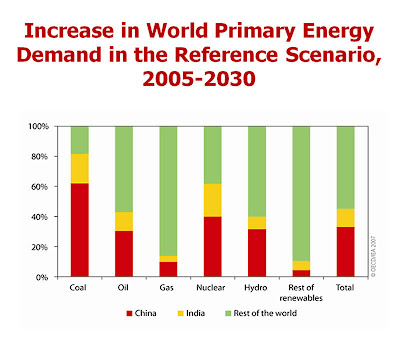EMISSIONS: IT’S WORSE THAN THEY THOUGHT
There is still time.
World carbon intensity – emissions/unit of energy – is rising. Faster than the best early estimates predicted.
Those early estimates were made by the International Panel on Climate Change (IPCC). The IPCC assumed 57% to 96% of emissions would be cut “spontaneously” in favor of New Energy, energy efficiency and sustainability.
Ain’t happening. Roger Pielke Jr., lead author, Dangerous Assumptions: "According to the IPCC report, the majority of the emission reductions required to stabilize CO2 concentrations are assumed to occur automatically…Not only is this reduction unlikely to happen under current policies, but we are moving in the opposite direction right now. We believe these kinds of assumptions in the analysis blind us to reality and could potentially distort our ability to develop effective policies."
Unfortunately, the study authors found that new technology development is “frozen” and world economic growth is still coming largely from fossil fuels.
Next idea: Government policy generated by responsible leaders to spur development of the new technology is desperately needed. U.S. voters reading this are now laughing. Fortunately, there is leadership in the EU and Japan, proving it is possible.
Roger Pielke Jr., lead author, Dangerous Assumptions: "In the end, our message should be viewed optimistically rather than pessimistically…because it is only with a clear-eyed view of the mitigation challenge that we can ever hope to adopt effective policies. We hope that our analysis is one step toward such a clear-eyed view."
There is still time.
 All the IPCC scenarios failed to guess technology uptake would remain frozen. (from the Nature article - click to enlarge)
All the IPCC scenarios failed to guess technology uptake would remain frozen. (from the Nature article - click to enlarge)Carbon Dioxide Emission Reduction Assumptions Overly Optimistic, Study Says
April 4, 2008 (National Center for Atmospheric Research via Science Daily)
WHO
Roger Pielke Jr., University of Colorado; Tom Wigley, National Center for Atmospheric Research (NCAR); Christopher Green, McGill University
WHAT
Dangerous Assumptions asserts that IPCC assumptions that world nations will cut emissions “spontaneously” are overly optimistic.
 As developed nations move away from coal, India and China are building it. (click to enlarge)
As developed nations move away from coal, India and China are building it. (click to enlarge)WHEN
- 1992: United Nations Framework Convention on Climate Change (UNFCCC) approved to stabilize CO2 and other greenhouse gases.
- 2008: Findings were published in the April 3 issue of Nature
 Developed nations remain the biggest problem - for now. (click to enlarge)
Developed nations remain the biggest problem - for now. (click to enlarge)WHERE
- UNFCCC approved by almost all countries, including the U.S.
- In Asia and Africa, carbon instensity is rising dramatically as emerging nations rely on fossil fuels for growth.
WHY
- Most scientists agree the level of CO2 in the atmosphere must be stabilized below 500 parts per million (ppm), now at 380 ppm, by mid century or the world will face irreversible changes by the end of the century.
- The IPCC assumptions of “spontaneous” reductions in emissions was based on optimistic assumptions about the development of technologies and market approaches. The authors of the study began with “frozen technology” assumptions and arrived at the conclusion things are not improving.
- Funding came from the University Corporation for Atmospheric Research (UCAR) which operates the National Center for Atmospheric Research under primary sponsorship by the National Science Foundation.
 Wanna cut emissions? Build wind and sun. (click to enlarge)
Wanna cut emissions? Build wind and sun. (click to enlarge)QUOTES
- Dangerous Assumptions: "In the end, there is no question whether technological innovation is necessary--it is…The question is, to what degree should policy focus explicitly on motivating such innovation…The IPCC plays a risky game in assuming that spontaneous advances in technological innovation will carry most of the burden of achieving future emissions reductions, rather than focusing on those conditions that are necessary and sufficient for those innovations to occur."
- Tom Wigley, co-author: "Stabilization is a more daunting challenge than many realize and requires a radical 'decarbonization' of energy systems…Global energy demand is projected to grow rapidly, and these huge new demands must be met by largely carbon-neutral energy sources--sources that either do not use fossil fuels or that capture and store any emitted CO2."
- Christopher Green, co-author: "With a frozen technology approach, the full scope of the carbon-neutral technology challenge is placed into clear view…"








0 Comments:
Post a Comment
<< Home